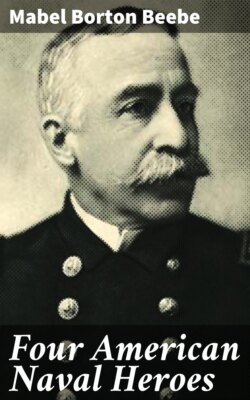Читать книгу Four American Naval Heroes - Mabel Borton Beebe - Страница 10
V.—The Cruise of the Alfred.
ОглавлениеThe young lieutenant was now twenty-nine years old. His health was excellent and he could endure great fatigue. His figure was light, graceful, and active. His face was stern and his manner was soldierly. He was a fine seaman and familiar with armed vessels.
He knew that the men placed above him in the navy had had less experience than he. But he took the position given him without complaint.
When the commander of the Alfred came on board, Paul Jones hoisted the American flag. This was the first time a flag of our own had ever been raised.
THE PINE TREE FLAG.
We do not know just what this flag was like, but some of the earliest naval flags bore the picture of a pine tree; others had a rattlesnake stretched across the stripes, and the words, "Don't tread on me." Our present flag was not adopted until two years later.
On the 17th of February, 1776, the first American squadron sailed for the Bahama Islands.
On the way, two British sloops were captured. The English sailors told the Americans that on the island of New Providence were forts, which contained a large amount of military supplies. They said that these forts could easily be taken.
The soldiers on a vessel are called marines. A plan was made to hide the American marines in the British sloops. In that way it was thought they could go safely into the harbor of New Providence. Then they could land and take possession of the forts.
THE RATTLESNAKE FLAG.
This plan would have been successful, but for one foolish mistake. The squadron sailed so close to the harbor during the night that in the morning all the ships could be seen from the shore. The war vessels should have remained out of sight until the marines had been safely landed from the sloops. The alarm was spread, and the sloops were not allowed to cross the bar.
The commander of the squadron then planned to land on the opposite side of the island and take the forts from the rear, but Paul Jones told him he could not do this. There was no place to anchor the squadron, and no road to the forts.
However, he had learned from the pilots of a good landing not far from the harbor. When he told the commander of this, he was only rebuked for confiding in pilots.
So Paul Jones undertook, alone, to conduct the Alfred to the landing he had found. He succeeded in doing this and the whole squadron afterwards followed.
The English soldiers abandoned the forts, and the squadron sailed away the same day, carrying a hundred cannon and other military stores.
